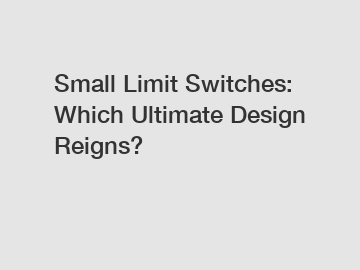Dec. 26, 2023
Electrical Equipment
Small Limit Switches: Which Ultimate Design Reigns?
In the world of electrical engineering, small limit switches play a crucial role in controlling and monitoring the movement of mechanical systems. These small yet powerful devices have revolutionized the way modern machines operate. With numerous design options available, engineers often find themselves pondering over the question, "Which ultimate design reigns?" Let's delve into this topic and explore the various designs and factors to consider when choosing a small limit switch.
1. Roller Lever Design:

One commonly used design for small limit switches is the roller lever. As the name suggests, this design incorporates a lever with a roller at the end. This roller acts as a mechanical extension that detects the position of moving components. The advantage of this design is its versatility for different applications. The roller lever can easily adapt to various types of machinery, providing reliable actuation at specific positions. However, its drawback is that it requires more space, making it unsuitable for compact systems.
2. Plunger Type Design:
Another popular design is the plunger-type switch. This design consists of a spring-loaded plunger that extends and retracts based on the applied force. These switches are commonly used in applications where linear movement needs to be detected, such as in doors or gates. The plunger type design offers a compact form factor and higher sensitivity. However, it may not be suitable for some applications that require a higher actuation force or complex movement detection.
3. Rotary Type Design:
For applications involving rotational movement, the rotary type switch design is often preferred. These switches utilize a rotating cam or wheel to detect the position of rotating components. Rotary limit switches are commonly used in conveyor systems, cranes, or robotic arms. They provide accurate position sensing and a wide range of customization options. However, these switches may not be well-suited for linear or motionless systems.
4. Sealed Design:
In certain environments, limit switches are exposed to extreme conditions, such as dust, moisture, or chemicals. To counteract these challenges, the sealed design was introduced. Sealed limit switches are enclosed in a protective casing that shields them from external factors. This design ensures the longevity and reliability of the switch, even in harsh environments. However, the sealing mechanism can add bulk and complexity to the switch, limiting its application in certain scenarios.
Further reading:Now that we have explored different designs of small limit switches, let's consider a few crucial factors to consider when choosing the ultimate design for a specific application.
a. Size and Mounting Options:
It is essential to consider the available space and mounting requirements of the application. Roller lever switches may be suitable for larger machines, while plunger or rotary switches offer a more compact solution. Understanding the space constraints and mounting options can help engineers select the right design.
b. Actuation Force and Sensitivity:
Different applications require different actuation forces and levels of sensitivity. Plunger-type switches are known for their lower actuation force, while roller lever or rotary switches can handle higher forces. Considering the desired actuation force and necessary sensitivity is vital for proper functionality.
c. Environmental Considerations:
The operating environment plays a significant role in deciding the design of a limit switch. Sealed switches are ideal for dusty or corrosive environments, ensuring the switch's longevity and accuracy. Understanding the environmental conditions can help engineers select the most suitable design to withstand these challenges.
d. Cost and Availability:
Cost and availability are always important factors to consider in engineering projects. While certain designs may provide specific advantages, their availability and cost can impact the overall feasibility of the project. Engineers must strike a balance between functionality and affordability when choosing the ultimate design.
In conclusion, choosing the ultimate design for small limit switches depends on various factors such as size, actuation force, environmental requirements, and cost. While the roller lever, plunger, rotary, and sealed designs offer unique advantages, the selection should be based on the specific needs of the application. By carefully considering these factors, engineers can ensure optimal performance and reliability in their systems. So, when it comes to small limit switches, there is no one-size-fits-all answer to the question, "Which ultimate design reigns?" It all depends on the specific requirements of the engineering project at hand.
If you are looking for more details, kindly visit Adjustable Small Roller Lever Actuator Limit Switch, Industrial Limit Switch, Spring Lever Actuator Limit Switch Supplier.
Further reading:Previous: What store has the best battery prices?
Next: H05V2-K vs H07V2-K: Which cable offers superior performance and durability?
Related Articles
If you are interested in sending in a Guest Blogger Submission,welcome to write for us!
All Comments ( 0 )